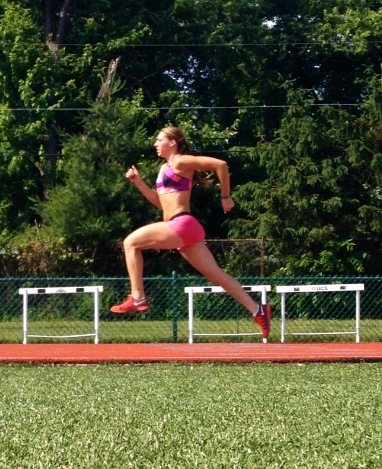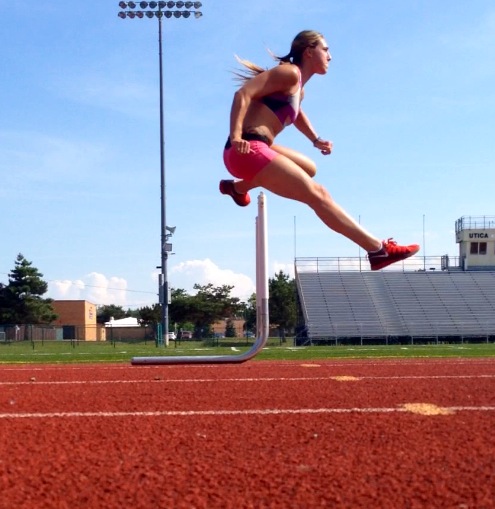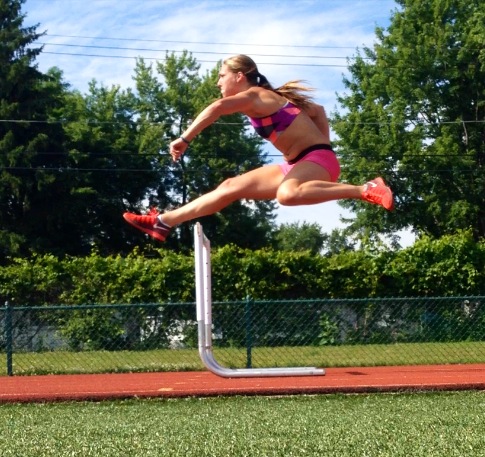Breanna Peabody: Running is in Her Blood
Do what makes you happy, be with who makes you smile, laugh as much as you breathe, love as long as you live.
– Breanna Peabody
For every track athlete who earns an endorsement contract straight out of college and embarks on a professional career, there are hundreds of athletes who have yet to reach that level of success. These athletes must figure out ways to continue training and competing without the safety net of financial security. While the stories of world class athletes are quite fascinating, the stories of athletes who are a notch or two below can be equally riveting, and equally inspiring. One such story is that of Breanna Peabody, a 23-year-old hurdler who graduated from Oakland University (in Michigan) in 2013. Peabody currently serves as an assistant coach at her alma mater while she trains and competes for PRTC-Elite – a small training group for post-collegians in Oakland County led by Paul Rice, who also heads the Oakland U. track and field program.
[am4show not_have=”g5;”]
[/am4show][am4guest]
[/am4guest][am4show have=”g5;”]
The product of very athletic parents, Peabody was heavily involved in sports from a young age. Her father ran cross country and her mother played volleyball, so Peabody “kind of picked up where they left off, and did a lot more.” Beginning in seventh grade, she played volleyball in the fall, basketball in the winter, and ran track in the spring.
In today’s era of athletic specialization, a three-sport athlete at the high school level is a throwback to a bygone era. But Peabody does not feel that her volleyball and basketball exploits impeded her progress in track; instead, she feels like the other two sports served to enhance her track endeavors.
“Basketball and volleyball helped me condition my way into my running career,” she explains. “Especially basketball, because of the weight program we followed. An outside group called Level Fitness came in and trained us. That’s when I first started lifting, getting powerful. From the start of tenth grade I started seeing an improvement in being prepared for track season.”
She did have a setback her junior year, though. At volleyball practice right before the regional championships, she landed funny after jumping for the ball and fractured her ankle. Her volleyball season came to an abrupt end, but she recovered in time to finish in the top five at the state meet in the 100 hurdles.
“Other than that one setback,” she says, “playing the other two sports helped me a lot to get ready for track season. I think if I had just done track, I can’t tell you what I probably would’ve done in the fall and winter to fill up that time. I don’t know if the [track] coaches would’ve gotten us ready that early.”
Though she had dabbled in the hurdles as a middle-schooler, running the 200 meter hurdles as a 7th and 8th grader, she didn’t get serious about the hurdles until her 10th-grade year, when one of the top athlete’s on the varsity team at Utica High School suffered, ironically enough, a broken ankle.
“The coaches came over to me and asked if I would try the hurdles,” she explains. “I naturally three-stepped. They said, ‘You’re gonna be a hurdler.’ From that point, I started my hurdle career.”
While Utica High’s coaching staff wasn’t stellar – “my hurdle coach was my chemistry teacher” – the coaches taught her enough to help her earn a full athletic scholarship to Oakland University. She went undefeated in the 100 hurdles and 300 hurdles (not including state meets) throughout her high school career. “I was unstoppable,” she recalls. “I still have the 100 hurdle and 300 hurdle school records. No one has even come close.”
Peabody finished her high school career with personal bests of 14.4 and 44.4. She also ran on a 4×400 relay team that ran 3:58 (which was also a school record at the time) and long-jumped 17-5 indoors. In the hurdling events, she made it to state meet four years in a row.
Not until her senior year did Peabody know she wanted to pursue track in college. First she wanted to pursue volleyball, so she joined Michigan Elite Volleyball Club. But she quit after half a season when Coach Rice at Oakland University offered her a scholarship to run track.
The transition from high school to college proved to be a difficult one, both in regard to training and competing. But Peabody had never been one to back down from a challenge, and she wasn’t about to start now.
The first thing she noticed was that the practices were much more intense, which was something she welcomed. “Practices weren’t that demanding in high school,” she says. “You showed up, practiced, ran a meet, went home. We didn’t do anything extra. After a few weeks in college, I realized what the difference was. Workouts were much more focused on speed one or two days a week, technique one or two days a week. The coaching staff focused on what you needed to improve on. They really worked with you. So training-wise, the transition was great.”
 But the competition at the collegiate level required an adjustment, as she was no longer the fastest girl on the track. “I was kind of bummed at first,” she admits. It was like, I used to be undefeated. But I did realize the mental and physical toughness of what college sports is really about, because you’re getting these people coming from all over the country, from different states, whereas in high school you’re only competing against people in your county. These collegiate athletes had different training than you did in high school. The competition in college scared me at first, but I got used to it. I realized these girls are pushing me to a new limit. In high school I didn’t have that because I was the only one in front. I liked the change. I was breaking personal records my first year.”
But the competition at the collegiate level required an adjustment, as she was no longer the fastest girl on the track. “I was kind of bummed at first,” she admits. It was like, I used to be undefeated. But I did realize the mental and physical toughness of what college sports is really about, because you’re getting these people coming from all over the country, from different states, whereas in high school you’re only competing against people in your county. These collegiate athletes had different training than you did in high school. The competition in college scared me at first, but I got used to it. I realized these girls are pushing me to a new limit. In high school I didn’t have that because I was the only one in front. I liked the change. I was breaking personal records my first year.”
Her freshman and sophomore years, Peabody competed in the pentathlon, which meant she was practicing for five events. One day she’d work on her mid-distance, one day would be hurdles, then high jump and shot-put that same night.
Still, she considers the 400 hurdles to have been her best event as a collegian. She qualified for NCAA Nationals last year, and “was probably the fourth or fifth athlete from Oakland who [ever] made it.” In her last two years, she focused almost exclusively on the longer hurdle race. “I didn’t run the 100 hurdles anymore,” she says. “By my last year, I cut my time by two seconds, down to 59.29, the week before nationals, at the Toledo invitational. Coach Rice and I both agreed that if we focused on one event, we could see my improvement and what I’m capable of. Turns out I was capable of much more than I thought I would be.”
This past year, her first as a post-collegian, Peabody focused on the 400 hurdles again, but her best time was only 61.4, so she plans on returning her focus to the 100 hurdles for the 2014-15 season. With a personal best of 14.2, she thinks, with proper training, she can drop a second off her time and “be where I wanna be.”
To no small degree, her drop-off in the 400 hurdles can be credited to the enormously difficult transition to life as a post-collegiate athlete. The lack of financial security, the hectic daily schedule, as well as the comparatively small number of meets, made 2014 a figure-it-out-as-you-go year for her and fellow Oakland Alum and training partner Niklas Rippon, a 110 hurdler who graduated the same year as Peabody and constitutes the other half of PRTC Elite.
“In college,” Peabody says, “Niklas and I had a scholarship. Now a year out of college you don’t have that backbone anymore. Starting off indoor season, we talked to friends and family, put together a flyer explaining what we were doing. Niklas put together a spreadsheet of the cost of everything. Food, entry fees, gas – for each meet. That was hard at first because we didn’t even have jerseys yet for PRTC Elite. We only had probably 400 bucks under our belt for the first couple meets. We tried to spread it out. We packed our own lunches instead of wasting money stopping on the way. It’s definitely harder than I thought.”
Peabody and Rippon were worried that the money might run out before they even made it to the outdoor season. But they hosted a fundraiser at the end of winter. About thirty people showed up, and they made about $600. Per the suggestion of Coach Rice, they made a blog page, Peabody put up a sponsor page with a donation button that went directly to their gofundme page. They also created a Facebook page and a Twitter account.
“We put ourselves out there, letting people know who we are,” Peabody says. “Once we did all that, people saw what we were doing and how passionate we were. We ended up raising $3000 for indoor and outdoor season. We did get gear, from a place called Running Gear. Coach Rice ended up making a deal with them. They donated jerseys, warm-ups, long-sleeved shirts and short-sleeved shirts. Now when we’d go to meets, we’d have our own logo. At first we were registering as PRTC Elite but no one even knew who we were.”
When it came to cutting costs when traveling, Peabody and Rippon had to be creative. They would share a hotel room with two queen-sized beds instead of staying in separate rooms, which saved them $100 on average. They couldn’t travel with the Oakland team, even though they competed at many of the same meets and Peabody was an assistant coach and Rippon was a volunteer assistant. Because they were post-collegiate athletes, traveling with the team would be a violation of NCAA rules. So they had to ride separately and meet the team at the venue. To save gas, sometimes they took Peabody’s car, sometimes they took Rippon’s. “Travel was the hardest part,” Peabody says.
Next year, Peabody plans on changing things up a bit. In order to get more one-on-one time with Coach Rice, she’ll practice earlier in the day. That will also help her to give her full focus to her athletes when it comes time to coach them. She also plans to go to different meets than the Oakland team, for the same reasons. “That way,” she says, “I’ll get my time and my time with the athletes. This year, Niklas and I were coaching each other most of the time.”
When asked to describe a day in the life of the post-collegiate athlete, Peabody says she wakes up, changes, eats a small snack – a protein bar or banana – then heads to Oakland, where she has free reign to use all their facilities. “On a lifting day I’d go down to the gym, sometimes by myself but usually with Niklas. We’d get our lift in, we’d sometimes have a workout after, at Avondale High School’s outdoor track. We’d do our hurdle warmup, do our whole hurdle workout. Usually the [training] day ends there.”
But the day as a whole is far from over. Besides coaching the sprinters and hurdlers at Oakland, Peabody works as a crowd control staff member at the Palace of Auburn Hills. “I got that job at the end of indoor season,” she says. “It was my first time having a job while running track. So I’d work out in the morning, coach in the afternoon, work at night. It wasn’t too bad. I didn’t have any stress about it. I got through my day. Right now I’m working two jobs plus training, plus coaching. So that’s like having four jobs really. Which is hard because you put in a lot of hours at work, plus training six days a week.”
 In explaining her uncommon drive and determination, Peabody gives credit to those who have set the example for her. Particularly Rippon, as well as her best friend, Brittni Hutton – a distance runner currently living in Colorado Springs and running professionally. About Rippon she says, “I look at him and see dedication every single workout.” About Hutton she says, “She’s always there for me, pushing me through the good times and the bad.” She also gives credit to the hurdlers she competes against, remarking that “everyone pushes each other; they’re always supporting you and giving you motivation.”
In explaining her uncommon drive and determination, Peabody gives credit to those who have set the example for her. Particularly Rippon, as well as her best friend, Brittni Hutton – a distance runner currently living in Colorado Springs and running professionally. About Rippon she says, “I look at him and see dedication every single workout.” About Hutton she says, “She’s always there for me, pushing me through the good times and the bad.” She also gives credit to the hurdlers she competes against, remarking that “everyone pushes each other; they’re always supporting you and giving you motivation.”
Peabody is also driven by a fervent desire to find out just how fast she is capable of running. With the dramatic improvement she had in the 400 hurdles in 2013, she is eager to discover just how far her talent and exceptional work ethic can take her. In switching her emphasis to the 100 hurdles for the upcoming season, she feels confident that putting in the speed work and strength work will enable her to run at a whole new level.
When starting out as a three-sport athlete in the seventh grade, Peabody had no way of knowing that her path would end up being that of a hurdler. Heck, by committing to Oakland in her senior year of high school, she had to back out of a commitment to play volleyball at Macomb Community College. But she has come to understand that “running is in my blood. That’s why I went to Oakland. I have always kept pushing myself. And realizing the potential I had, I just couldn’t stop. I had to keep going. I wanted to prove to myself that I can do more without giving up. That’s why I’m here today, doing what I love.”
At this post-collegiate level, where running is an integral part of one’s livelihood, “every practice becomes so detailed. I’m constantly asking, What do I need to do to get to this point, and how am I gonna do it?”
Peabody’s goal is to qualify for the Olympic Trials. The USATF Outdoor Championships qualifying standard for the 100m hurdles, assuming it doesn’t change, is 13.10. So Peabody will have to drop more than a second from her current personal best to make it.
“I think I can do it,” she says. “I know that’s saying a lot, but it’s a huge goal of mine, and always has been, ever since I could run. I would always tell people, Hey I’m gonna make it to the Olympic Trials.”
Add me to the list of those who believe she will.
***
Link to the PRTC Elite team page: http://brepeabody.wix.com/prtcelite
Link to the PRTC Elite Facebook page: https://www.facebook.com/prtcelite
Link to the PRTC Elite Twitter page: https://twitter.com/prtcelite
[/am4show]

